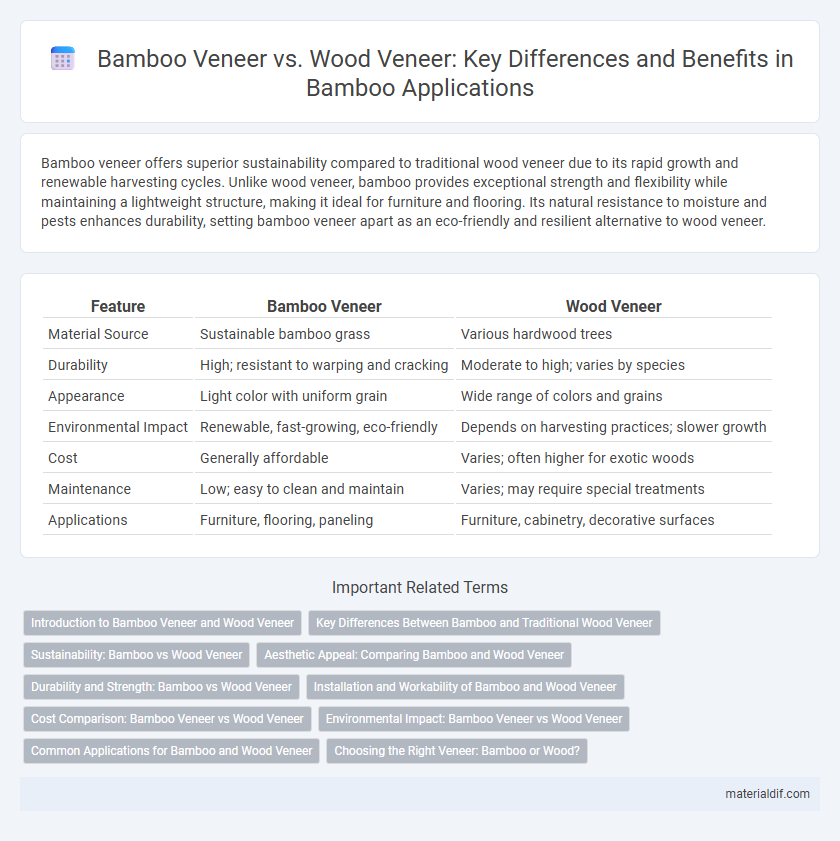Bamboo veneer offers superior sustainability compared to traditional wood veneer due to its rapid growth and renewable harvesting cycles. Unlike wood veneer, bamboo provides exceptional strength and flexibility while maintaining a lightweight structure, making it ideal for furniture and flooring. Its natural resistance to moisture and pests enhances durability, setting bamboo veneer apart as an eco-friendly and resilient alternative to wood veneer.
Table of Comparison
| Feature | Bamboo Veneer | Wood Veneer |
|---|---|---|
| Material Source | Sustainable bamboo grass | Various hardwood trees |
| Durability | High; resistant to warping and cracking | Moderate to high; varies by species |
| Appearance | Light color with uniform grain | Wide range of colors and grains |
| Environmental Impact | Renewable, fast-growing, eco-friendly | Depends on harvesting practices; slower growth |
| Cost | Generally affordable | Varies; often higher for exotic woods |
| Maintenance | Low; easy to clean and maintain | Varies; may require special treatments |
| Applications | Furniture, flooring, paneling | Furniture, cabinetry, decorative surfaces |
Introduction to Bamboo Veneer and Wood Veneer
Bamboo veneer offers a sustainable, eco-friendly alternative to traditional wood veneer, made by slicing thin layers from bamboo stalks. Its rapid growth rate and renewable nature make bamboo an ideal choice for environmentally conscious woodworking projects. Wood veneer, derived from various hardwood species, provides diverse grain patterns and durability but often comes with higher environmental costs due to slower tree growth.
Key Differences Between Bamboo and Traditional Wood Veneer
Bamboo veneer is composed of fast-growing, renewable grass fibers, offering superior sustainability compared to traditional wood veneer derived from slower-growing hardwood trees. Bamboo veneer exhibits higher tensile strength and moisture resistance, making it more durable for various applications such as flooring and cabinetry. Unlike wood veneer, bamboo typically presents a more uniform grain pattern and lighter color, influencing aesthetic and design choices.
Sustainability: Bamboo vs Wood Veneer
Bamboo veneer outperforms traditional wood veneer in sustainability due to its rapid growth cycle, reaching maturity in 3-5 years compared to decades for hardwood trees. Bamboo's ability to regenerate without replanting minimizes deforestation and soil erosion, promoting eco-friendly harvesting practices. Wood veneer often relies on slower-growing species, increasing environmental impact and resource depletion over time.
Aesthetic Appeal: Comparing Bamboo and Wood Veneer
Bamboo veneer offers a unique aesthetic appeal with its natural linear grain and warm golden hues, creating a contemporary and exotic look that differs from traditional wood veneer. Wood veneer presents a wide range of grain patterns and color variations, from smooth and subtle to bold and dramatic, allowing for versatile design applications. Both materials provide distinct visual textures and richness, but bamboo veneer often emphasizes sustainability alongside its modern, sleek appearance.
Durability and Strength: Bamboo vs Wood Veneer
Bamboo veneer exhibits superior durability and strength compared to traditional wood veneer due to its dense fiber structure and rapid maturity, resulting in a higher tensile strength of up to 28,000 psi. Unlike wood veneer, bamboo is naturally resistant to moisture, insects, and warping, making it ideal for high-traffic and humid environments. Wood veneers typically have lower strength and durability, requiring more maintenance and protection against environmental factors.
Installation and Workability of Bamboo and Wood Veneer
Bamboo veneer offers superior flexibility and ease of installation compared to traditional wood veneer, making it ideal for complex or curved surfaces. Its consistent texture and uniform thickness reduce the risk of splitting and cracking during application. Wood veneer often requires careful handling and acclimatization to avoid warping, which can extend installation time and complicate the work process.
Cost Comparison: Bamboo Veneer vs Wood Veneer
Bamboo veneer offers a more cost-effective alternative to traditional wood veneer due to its rapid growth rate and sustainable harvesting methods, reducing raw material expenses. Wood veneer, especially from hardwood species, tends to be more expensive because of longer growth cycles and limited availability, driving up costs. The affordability of bamboo veneer makes it a popular choice for environmentally conscious projects seeking a balance between budget and aesthetics.
Environmental Impact: Bamboo Veneer vs Wood Veneer
Bamboo veneer offers a significantly lower environmental impact compared to traditional wood veneer due to its rapid growth rate and renewable harvesting cycle of 3-5 years versus decades for hardwood trees. Bamboo plantations require less water and no pesticides, contributing to enhanced soil conservation and reduced carbon emissions. The carbon sequestration ability of bamboo is also higher, making it a more sustainable choice for eco-conscious furniture and interior design applications.
Common Applications for Bamboo and Wood Veneer
Bamboo veneer is commonly used in flooring, furniture, and decorative wall panels due to its sustainability, flexibility, and unique grain patterns. Wood veneer frequently appears in cabinetry, high-end furniture, and architectural millwork, valued for its traditional aesthetic and variety of species like oak, maple, and cherry. Both veneers serve as eco-friendly alternatives to solid wood, with bamboo favored for rapid renewability and wood veneer prized for classic appeal and structural versatility.
Choosing the Right Veneer: Bamboo or Wood?
Bamboo veneer offers exceptional sustainability due to its rapid growth rate and renewable harvesting, making it an eco-friendly alternative to traditional wood veneer, which often involves slower-growing hardwoods. Bamboo's natural hardness and resistance to moisture provide durable, long-lasting surfaces ideal for flooring and furniture, while wood veneer offers a wider variety of grain patterns and colors suitable for design versatility. Selecting the right veneer depends on priorities such as environmental impact, durability, and aesthetic needs, with bamboo excelling in sustainability and resilience, and wood providing greater design diversity.
Bamboo veneer vs Wood veneer Infographic

 materialdif.com
materialdif.com